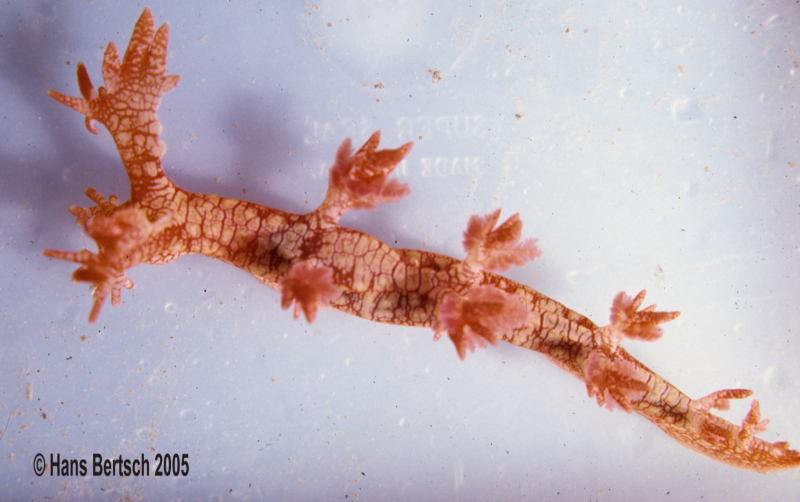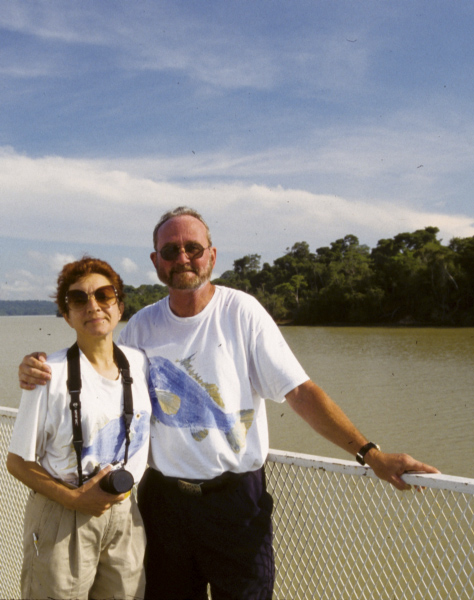 |
Bornella calcarata
Photos courtesy Dr. Hans Bertsch
Panamá (living animals) and Berkeley, Calif. (SEMs)
Bornella calcarata Mörch, 1863
With the species, I continue my sporadic BOWs of Caribbean nudibranch species.
This rare species was originally named from St. Thomas, U.S.V.I. (before they belonged to the United States). The etymology has a typical mid-1800s Latin usage. The Latin word calcar means “a spur.” The historian Livy (59 BCE–71 CE) wrote, “”equum calcaribus concitare,” loosely translated, “to spur on the horse.” Extended meanings of the word include stimulus and incitement. So this is a truly stimulating nudibranch! Form, color and movements.
I collected this species in Panamá many years ago. I did not find it when I spent 4 months on St. John, U.S.V.I. Typical for nudibranchs in the Caribbean, it is rare and hard to find. There is a distinct paucity of nudibranchs in the Caribbean. That is a question to be answered: “Why?” But there are further biogeographic questions about the genus that I will address later in this BOW.
It is worth citing the original description of this species by M.O.A.L. Mörch (1863, “Contributions a la faune malacologique des Antilles danoises,” Journal de Conchyliologie 11: 21-43). From pages 56-57: “C. compressum, vesiculoso-areolatum, rugosum, dorso latiore, utrinque facsiculis sex positice sensim minoribus e papillis planis validis 2-6 inaequalibus et pumilis branchiabulus 2-4 brevibus ramoso-pettatis compositis. Papilla acuta solitaria in apice postico dorsi sita. Vaginae rhinophorum validae, rugose, uti squamosae, carina dorsali compressa, latissima, superne lobis digitalis 4-5 inaequalibus erectis; foramina rhinophorum parva, antice papillis planis, acutis, longiusculis trinatis divergentibus ornata. Frons utrinque fasciculo stellato e papillis parvis obtusis 9-10 radiatilibus composito. Rima ovalis subovalis; maxillae laterales flaxae, convexae, sed aciem non vidi. Clypeus frontalis parvus forma ferri equini. Solea pedis contractione canaliculata, limbo undulato, extus linea impressa notato, postice acutissima, producta. Long. circ. 65 mm.”
Midway through the description, he compares the animal’s body shape to a horse! Hence, the etymology.
The animal reaches 60-70 mm in total length. It is basically white with extraordinary bright red bandings and stripes over the entire body. Mörch noted the gills within the cerata; he also commented on the positioning of the rhinophores in their “pouch.”
This animal, typical for members of Bornella, swims by lateral movements of its body, with all their appendages waving and flapping through the water.
The radula (See SEM'S 411 AND 412) shows interlocking between the teeth (See SEM'S 413 AND 414 ) The cusp of the posterior tooth lies within a groove in the anterior tooth. Lateral teeth seem to be the typical cleaning or brushing up of the food item.
In 1980, I named the species Bornella sarape, and presented SEMs of Bornella adamsii, B. calcarata , and B. sarape. At that time, 6 species of Bornella were recognized. Since then, B. anguilla Johnson, 1985, has been named. All species occur within the circumtropical regions of the Caribbean, Indo-west-central Pacific and the eastern Pacific. Such a widespread distribution, for so few species, is a bit of a zoogeographic puzzle. It seems that an Indo-Pacific origin of this group is not unreasonable, with speciation within the Caribbean after the closure of the Panamic isthmus.
Additional Reference:
Bertsch, Hans. 1980. A new species of Bornella from tropical west-America (Mollusca, Opisthobranchia). Spixiana 3(1): 32-43.
WEBMASTER NOTES:
DR. HANS BERTSCH IS WELL KNOWN TO READERS OF “THE SLUG SITE.”
HERE HE IS WITH ROSA ON
GATUN LAKE, PANAMÁ
GATUN LAKE, PANAMA
JULY 2005

Send Hans email at hansmarvida@sbcglobal.net
|
